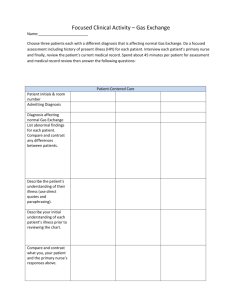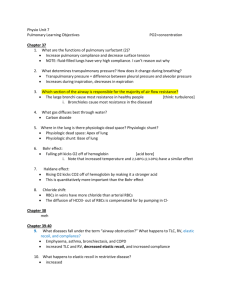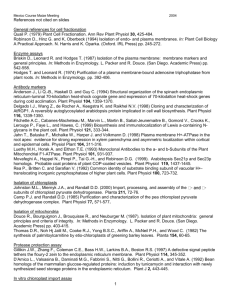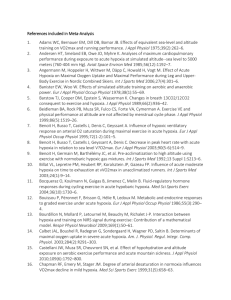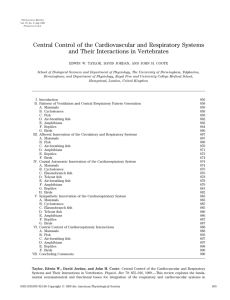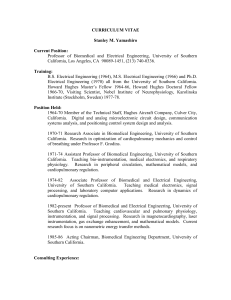Supplemental Text Box 7 Breath Interventions for Upregulating
advertisement
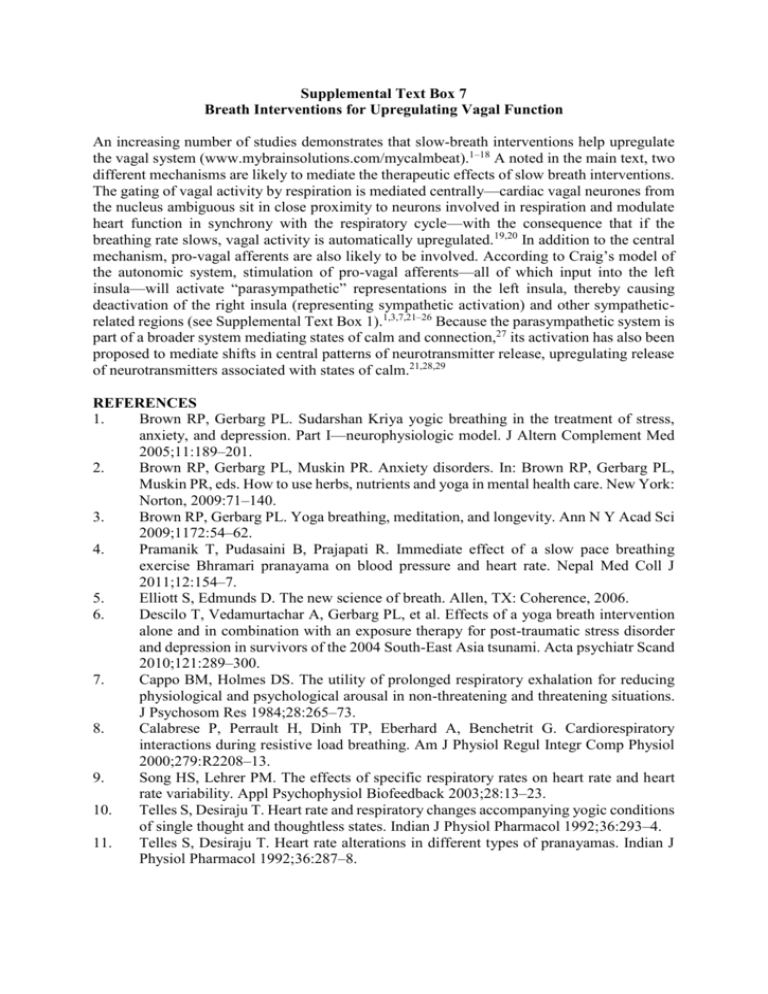
Supplemental Text Box 7 Breath Interventions for Upregulating Vagal Function An increasing number of studies demonstrates that slow-breath interventions help upregulate the vagal system (www.mybrainsolutions.com/mycalmbeat).1–18 A noted in the main text, two different mechanisms are likely to mediate the therapeutic effects of slow breath interventions. The gating of vagal activity by respiration is mediated centrally—cardiac vagal neurones from the nucleus ambiguous sit in close proximity to neurons involved in respiration and modulate heart function in synchrony with the respiratory cycle—with the consequence that if the breathing rate slows, vagal activity is automatically upregulated.19,20 In addition to the central mechanism, pro-vagal afferents are also likely to be involved. According to Craig’s model of the autonomic system, stimulation of pro-vagal afferents—all of which input into the left insula—will activate “parasympathetic” representations in the left insula, thereby causing deactivation of the right insula (representing sympathetic activation) and other sympatheticrelated regions (see Supplemental Text Box 1).1,3,7,21–26 Because the parasympathetic system is part of a broader system mediating states of calm and connection,27 its activation has also been proposed to mediate shifts in central patterns of neurotransmitter release, upregulating release of neurotransmitters associated with states of calm.21,28,29 REFERENCES 1. Brown RP, Gerbarg PL. Sudarshan Kriya yogic breathing in the treatment of stress, anxiety, and depression. Part I—neurophysiologic model. J Altern Complement Med 2005;11:189–201. 2. Brown RP, Gerbarg PL, Muskin PR. Anxiety disorders. In: Brown RP, Gerbarg PL, Muskin PR, eds. How to use herbs, nutrients and yoga in mental health care. New York: Norton, 2009:71–140. 3. Brown RP, Gerbarg PL. Yoga breathing, meditation, and longevity. Ann N Y Acad Sci 2009;1172:54–62. 4. Pramanik T, Pudasaini B, Prajapati R. Immediate effect of a slow pace breathing exercise Bhramari pranayama on blood pressure and heart rate. Nepal Med Coll J 2011;12:154–7. 5. Elliott S, Edmunds D. The new science of breath. Allen, TX: Coherence, 2006. 6. Descilo T, Vedamurtachar A, Gerbarg PL, et al. Effects of a yoga breath intervention alone and in combination with an exposure therapy for post-traumatic stress disorder and depression in survivors of the 2004 South-East Asia tsunami. Acta psychiatr Scand 2010;121:289–300. 7. Cappo BM, Holmes DS. The utility of prolonged respiratory exhalation for reducing physiological and psychological arousal in non-threatening and threatening situations. J Psychosom Res 1984;28:265–73. 8. Calabrese P, Perrault H, Dinh TP, Eberhard A, Benchetrit G. Cardiorespiratory interactions during resistive load breathing. Am J Physiol Regul Integr Comp Physiol 2000;279:R2208–13. 9. Song HS, Lehrer PM. The effects of specific respiratory rates on heart rate and heart rate variability. Appl Psychophysiol Biofeedback 2003;28:13–23. 10. Telles S, Desiraju T. Heart rate and respiratory changes accompanying yogic conditions of single thought and thoughtless states. Indian J Physiol Pharmacol 1992;36:293–4. 11. Telles S, Desiraju T. Heart rate alterations in different types of pranayamas. Indian J Physiol Pharmacol 1992;36:287–8. 12. 13. 14. 15. 16. 17. 18. 19. 20. 21. 22. 23. 24. 25. 26. 27. 28. 29. Vaschillo EG, Vaschillo B, Lehrer PM. Characteristics of resonance in heart rate variability stimulated by biofeedback. Appl Psychophysiol Biofeedback 2006;31:129– 42. Zucker TL, Samuelson KW, Muench F, Greenberg MA, Gevirtz RN. The effects of respiratory sinus arrhythmia biofeedback on heart rate variability and posttraumatic stress disorder symptoms: a pilot study. Appl Psychophysiol Biofeedback 2009;34:135–43. Tan G, Dao TK, Farmer L, Sutherland RJ, Gevirtz R. Heart rate variability (HRV) and posttraumatic stress disorder (PTSD): a pilot study. Appl Psychophysiol Biofeedback 2011;36:27–35. Gevirtz R. Autonomic Nervous System Markers for Psychophysiological, Anxiety, and Physical Disorders. In: Gordon E, Koslow SH, eds. Integrative neuroscience and personalized medicine. Oxford; New York: Oxford University Press; 2011:164–80. Gevirtz R. Resonant frequency training to restore homeostatsis for treatment of psychophysiological disorders. Biofeedback 2000;27:7–9. Lehrer P, Sasaki Y, Saito Y. Zazen and cardiac variability. Psychosom Med 1999;61:812–21. van der Kolk BA. Clinical implications of neuroscience research in PTSD. Ann N Y Acad Sci 2006;1071:277–93. Eckberg DL. The human respiratory gate. J Physiol 2003;548:339–52. Taylor EW, Jordan D, Coote JH. Central control of the cardiovascular and respiratory systems and their interactions in vertebrates. Physiol Rev 1999;79:855–916. Porges SW. The polyvagal theory: neurophysiological foundations of emotions, attachment, communication, and self-regulation. New York: Norton, 2011. Brown RP, Gerbarg PL. Sudarshan Kriya Yogic breathing in the treatment of stress, anxiety, and depression. Part II—clinical applications and guidelines. J Altern Complement Med 2005;11:711–7. Craig AD. Forebrain emotional asymmetry: a neuroanatomical basis? Trends Cogn Sci 2005;9:566–71. Devous MD, Husain M, Harris TS, Rush AJ. Effects of VNS on regional cerebral blood flow in depressed subjects. Eur Psychiatry 2002;17:113–4. Craig AD. Significance of the insula for the evolution of human awareness of feelings from the body. Ann N Y Acad Sci 2011;1225:72–82. Olausson H, Lamarre Y, Backlund H, et al. Unmyelinated tactile afferents signal touch and project to insular cortex. Nat Neurosci 2002;5:900–4. Uvanas-Moberg K, Arn I, Magnusson D. The psychobiology of emotion: the role of the oxytocinergic system. Int J Behav Med 2005;12:59–65. Streeter CC, Gerbarg PL, Saper RB, Ciraulo DA, Brown RP. Effects of yoga on the autonomic nervous system, gamma-aminobutyric-acid, and allostasis in epilepsy, depression, and post-traumatic stress disorder. Med Hypotheses 2012;78:571–9. Woodbury DM, Woodbury JW. Effects of vagal stimulation on experimentally induced seizures in rats. Epilepsia 1990;31 suppl 2:S7–19.
